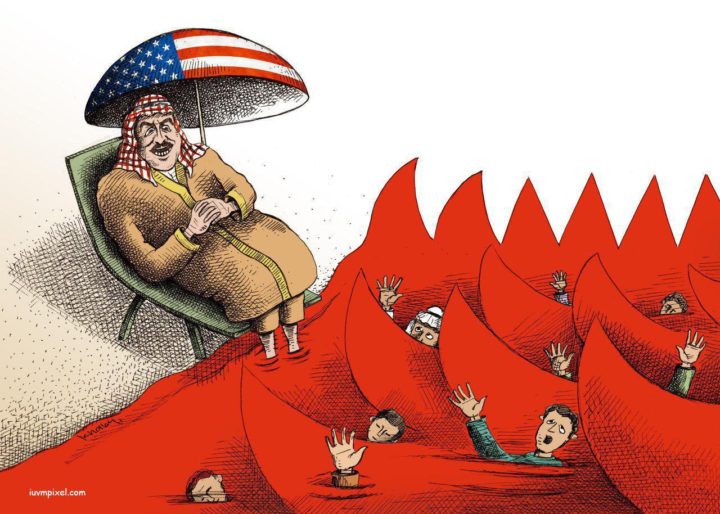While the Arab Spring saw revolutions across the Middle East, there is one revolution that has been suppressed on the ground, in the media, and by the US government: the Bahraini revolution. Bahrain has a population of only 1,425,171 and is ruled by a dictatorial-monarchy similar to those in Saudi Arabia and Qatar. Much like their fellow Arabs in neighboring nations, Bahraini protesters took to the streets in February 2011. Almost immediately, these peaceful Bahraini protesters were met with violent retaliation from the military of the Al Khalifa, Bahrain’s dictatorial royal family. Only a month later, the Saudi military, with the approval of the Al Khalifa, intervened to assist the Bahraini government in suppressing this anti-government uprising. Why has the violent suppression of the Bahraini people that continues to this day not gained any condemnation by Western governments like the US, while the revolutions in Libya, Egypt, and Tunisia have been supported? The Bahraini government serves as a key ally to the United States and many European nations, portraying a trend of US foreign policy supporting democracy in some countries and dictatorship in others.
In order to understand the extent of the Bahraini government’s oppression of its own people, we must look at Bahrain’s history, specifically the history of Bahrain’s House of Khalifa. In 1971, Bahrain became an independent state, and in 1973, the country held its first parliamentary election. However, the constitution was suspended and Isa bin Salman Al Khalifa, the Emir at the time, dissolved the assembly. The state of human rights deteriorated in the period between 1975 and 2001. Between 1994 and 1999, in what was known as the 1990s uprising, Bahrainis of all parties and political and religious ideologies joined forces to demand democratic reforms. Large, peaceful demonstrations were met with brutal force by Hamad ibn Isa Al Khalifa, resulting in the deaths of around 40 civilians and at least one Bahraini soldier.
The magnitude of the recent Bahraini revolution cannot be understated. Following revolutionary coups in Egypt and Tunisia, several hundred Bahraini protesters took to the streets on February 14th, 2011. Over thirty protesters were injured and one was killed as Bahraini government forces used tear gas and rubber bullets to break up demonstrations. The following day, security officers opened fire on mourners and 25 more were injured. Thousands of protesters marched to the Pearl Roundabout in Manama, setting up protest tents and camping out overnight. When 50,000 people marched to Manama to pay their respects to the victims, the army opened fire again, injuring dozens more and fatally wounding one. The following year, on March 14th, 2012, 1,000 troops from Saudi Arabia and 500 troops from UAE entered Bahrain and crushed the uprising.
The question arises: Why has the United States supported uprisings in places like Libya but not in countries like Bahrain or Saudi Arabia? Much like Saudi Arabia, Bahrain has a strong and old alliance with the United States. For one, Bahrain has provided a base for US naval activity in the Persian Gulf since 1947. Bahrain and the United States signed a Defense Cooperation Agreement in October 1991 granting US forces access to Bahraini facilities and ensuring the right to pre-position material for future crises. The country is also the headquarters of the US Navy’s Fifth Fleet, and in October 2001 the US designated Bahrain a Major non-NATO ally. Bahrain hosts the US Navy’s Fifth Fleet and participates in US-led military coalitions, including the Global Coalition to Defeat ISIS. Bahraini forces have supported the International Security Assistance Force in Afghanistan, providing perimeter security at a military base. Bahrain was the first Arab state to lead a Coalition Task Force patrolling the Gulf and has supported the coalition counter-piracy mission with a deployment of its flagship. In 2006, the US-Bahrain Free Trade Agreement entered into force generating additional commercial opportunities for both countries. Today, the USS Nimitz, one of the largest US warships in the world, is docked on the Persian Gulf.
Further, in 2017, the US State Department approved a $3.8 billion arms sales to Bahrain, including F-16 jets, missiles, and patrol boats. Hence, much of the weapons and brutal force used against the Bahraini people come from the United States, making the US a complicit partner in the oppression of the Bahraini people.
Given the old and strong US-Bahrain relations, one can understand why the US has not lifted a finger, let alone issue statements condemning the repression of peaceful demonstrations. This reveals a broader trend of the US government supporting some revolutions while hindering others to pursue its own interests. The tyrannical Al-Khalifa royal family works hand in hand with the US government, so why would the US government support a revolution that overthrows it? On the other hand, why has the United States supported revolution in Libya to the point where Libya has turned into a political vacuum? One can point to comments from Muammar Gaddafi’s speech at the Arab League in 2008, where he posed a question to his fellow Arab leaders regarding the execution of Saddam Hussein: “How can we accept that a foreign power [the United States] comes to topple an Arab leader while we stand watching?”
Analyzing why the US continues to support the authoritarian government of Bahrain, a definitive conclusion is reached: Bahrain serves as a proxy state and beneficiary for the US in the Middle East and as long as it plays that role, the Al-Khalifa’s brutality against the Bahraini people will not matter. The US, though it purports itself to be the defender of democracy, has failed to intervene in Bahrain. This inaction, combined with its strategic intervention in Libya, demonstrates that US foreign policy in the Middle East is determined primarily by its own imperialist interests, rather than notions of democracy.
